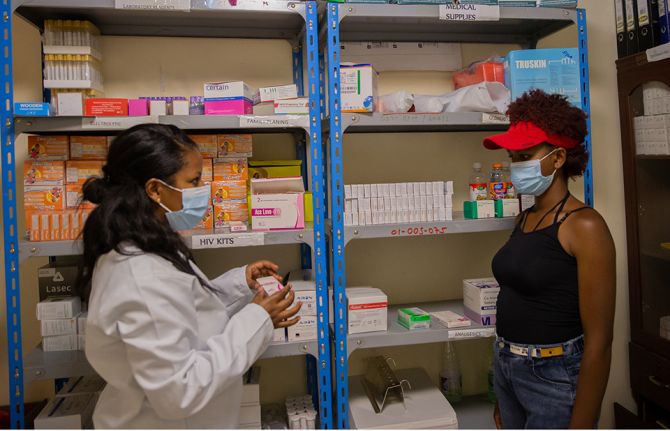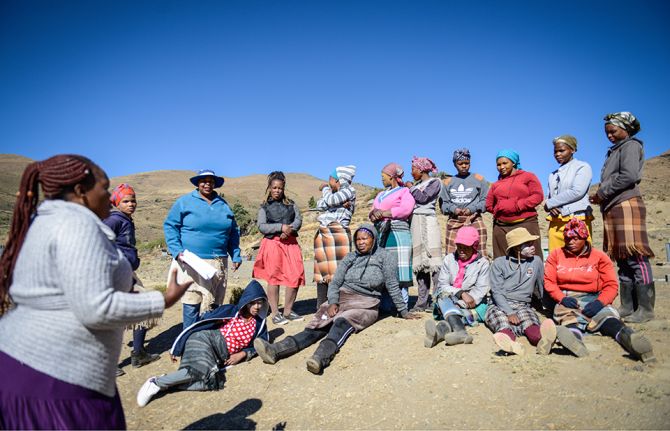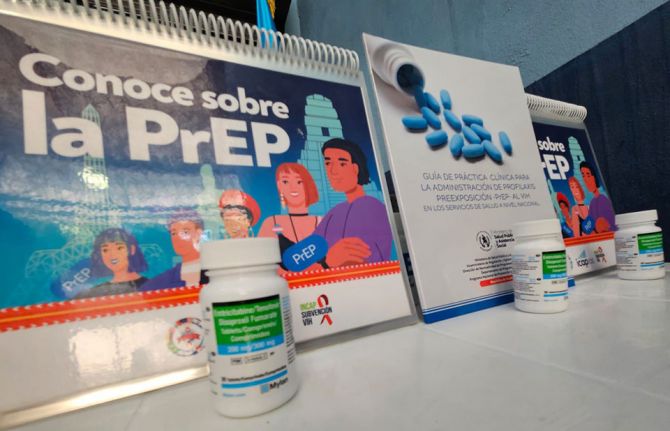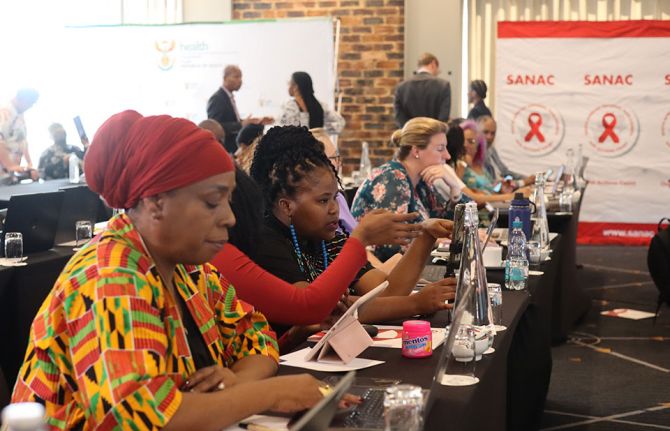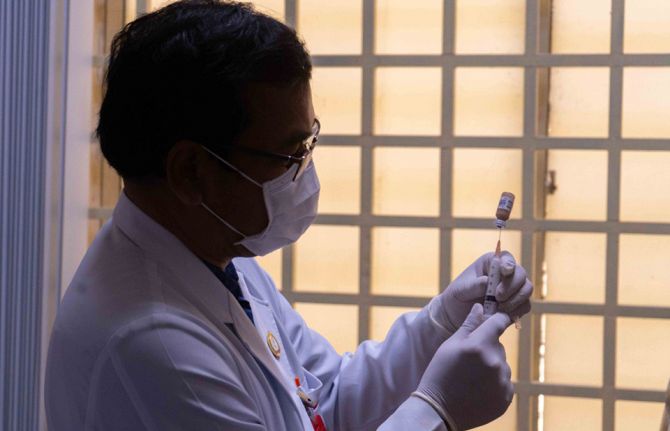
Update
UNAIDS Scientific and Technical Advisory Committee calls for HIV testing revolution
13 April 2017
13 April 2017 13 April 2017The participants of a meeting of the UNAIDS Scientific and Technical Advisory Committee (STAC) have called on UNAIDS to lead global efforts to galvanize an HIV testing revolution. The target is to achieve 90% of people living with HIV knowing their HIV status by 2020. In 2015, only 60% of people living with HIV knew their HIV status.
In a mid-term review of progress towards the 90–90–90 targets, held on 9 and 10 April in Geneva, Switzerland, the participants heard that late HIV diagnosis represents the single greatest barrier to increasing rates of HIV viral suppression globally. New testing technologies have emerged, but programmes must reach the people who need HIV testing services.
Key barriers to HIV testing uptake include lack of individual awareness of risk, stigma, legal and structural barriers, associated costs such as travel to facilities and the perception that there is little benefit from diagnosing HIV infection if no symptoms are present. The participants heard that many people avoid seeking HIV testing services at health facilities, since both travel and waiting times can often be long. Barriers to testing are often experienced by young people, men and members of key populations.
The participants agreed that political and financial support for HIV testing must be significantly increased and that the central focus of HIV testing services should be moved from the health facility to the community. Community workers have a critical role in scaling up these community-centred strategies. The STAC recommended that UNAIDS develop a road map for the HIV testing revolution, for review and comment by the STAC at its next meeting in July.
The STAC recommended that UNAIDS emphasize leveraging the 90–90–90 targets to better link the HIV response to the broader agenda for sustainable health. It was noted that HIV testing services provide a platform for screening for other health problems. Likewise, momentum towards the 90–90–90 targets also offers opportunities to address health workforce shortages.
Quotes
We need to be discontent. Although we have made considerable progress in our response to AIDS, we have much more to do, especially for those who are being left behind.
The HIV testing revolution must be a major element of our agenda. We must do a better job of reaching young men with HIV testing services, and we need to move HIV testing from the facility to the community.
We need to increase the pace of treatment scale-up. We added 2.4 million new people on HIV treatment in 2015, in both 2013 and 2014 the increase was 2.2 million. If we could increase annual enrolment in HIV treatment by 3 million, we could reach our global goal of having 30 million people on HIV treatment by 2020.
The rate of complete viral suppression in the population is the ultimate indication of how well we are doing with 90–90–90. We need to prioritize, ensuring that people on antiretroviral therapy receive viral load monitoring.
If we continue with the current rate of testing in Zimbabwe, that will not get us to the first 90. However, modelling indicates that we can reach the first 90 if we implement new forms of HIV testing, such as HIV self-testing.
Males and younger people have much lower rates of viral suppression in Malawi. Much of that is driven by their lower rates of antiretroviral therapy uptake.
Related

Update
Sweden—championing efforts to end AIDS
01 April 2017
01 April 2017 01 April 2017The global response to HIV has averted almost 9 million deaths since 2000, when the Millennium Development Goals (MDG) were set. Despite such progress, AIDS is the leading cause of death among women aged 15–49, the sixth leading cause of death among adolescents and a leading cause of death among children worldwide.
Recognizing the impact of HIV on health and development, in 2016 United Nations Member States adopted a Political Declaration on Ending AIDS to advance progress towards ending AIDS by 2030.
Essential to these efforts will be achieving the 90–90–90 targets, whereby, by 2020, 90% of people living with HIV know their HIV status, 90% of people who know their HIV-positive status are accessing treatment and 90% of people on treatment have suppressed viral loads.
In October 2016, Sweden announced that it was the first country to reach the 90–90–90 targets, having reached them in 2015. Today, Sweden estimates that 90% of people living with HIV in Sweden know their HIV status, 97% of people who know their HIV-positive status are accessing treatment and 95% of people living with HIV who are accessing treatment have viral suppression.
Sweden remains a political champion and supporter of HIV efforts globally. Sweden is also a key donor to UNAIDS and the Global Fund to Fight AIDS, Tuberculosis and Malaria. From 26 to 28 March, UNAIDS Executive Director Michel Sidibé visited Sweden, at the invitation of State Secretary Ulrika Modéer, to discuss how the response to HIV can be a catalyst for accelerating progress towards achieving the Sustainable Development Goals.
In meetings with a series of key political and technical stakeholders, as well as civil society organizations working on HIV, the participants stressed that HIV prevention must be expanded to end AIDS. They also stressed that HIV programmes must be integrated, brought to scale and implemented to maximum effect, ensuring they reach the people most affected by HIV.
There was consensus that a single disease approach to HIV is inadequate to reach the Sustainable Development Goals and that there is a need for an approach that looks on health not as an outcome but as a prerequisite for development and sustainability.
Quotes
“The HIV epidemic has been a cause and consequence of gender inequality for 30 years, but the HIV response is the conduit for transformative change and progress.”
“We need a systems change and a bold stance on structural issues, such as human rights and gender. Now is the time to ensure that we have a global health architecture fit for the Sustainable Development Goals era. UNAIDS has a key leadership role to play because of the intersection of HIV with health and development.”
“Broad-based partnerships beyond the HIV movement are key if we are to achieve the Sustainable Development Goals . We need to bring our prevention and sexual and reproductive health and rights efforts to scale.”
“We need a fourth 90, a 90 for quality of life of people living with HIV. People living with HIV in Sweden have a high quality of life, but some key populations continue to face policy and service barriers.”
Region/country











Update
CROI shows the importance of 90–90–90
21 February 2017
21 February 2017 21 February 2017A number of important updates were announced at the annual Conference on Retroviruses and Opportunistic Infections (CROI) that have shown the importance of, and ways to achieve, the 90–90–90 targets, whereby, by 2020, 90% of people living with HIV know their HIV status, 90% of people who know their HIV-positive status are accessing treatment and 90% of people on treatment have suppressed viral loads.
Held in Seattle, United States of America, from 13 to 16 February, CROI, the foremost annual scientific research conference on HIV, brought together around 4000 scientists, researchers, clinicians, students and others working in the response to HIV and related diseases.
A way of helping to meet the first 90—90% of people living with HIV knowing their HIV status—is the scale-up of self-testing. The STAR project, a four-year programme to build up HIV self-testing, has now distributed around 200 000 self-testing kits in Malawi, Zambia and Zimbabwe and is showing promising results. The project found that self-testing is a good way of reaching people who had previously not been reached before. Research is ongoing into the different ways the kits could be distributed—community-based distribution, pharmacy support, etc. With around 19 million people living with HIV not knowing that they have the virus, HIV self-testing could be a vital step towards ensuring that all who need HIV treatment have access to it.
The announcement of several promising new medicines in the pipeline may help to meet the second 90—90% of people who know their HIV-positive status are accessing treatment. A range of new single-dose, effective medicines, including new classes of medicine, new examples of existing classes and long-acting preparations that are produced by different manufacturers, will help to increase competition and hence access. Having new medicines will also be good news in the event of the development of resistance to current medicines in the future.
The importance of the third 90, viral suppression, and of a combination prevention approach to HIV was shown in a study in Rakai, Uganda. Studies of more than 33 000 people from 1999 to 2016 showed that an increase in antiretroviral therapy and hence viral suppression, scale-up of voluntary medical male circumcision and delayed sexual debut contributed to a 42% reduction in HIV incidence.
Also important for viral suppression is keeping people on treatment. The SWORD-1 and SWORD-2 studies show that a two-medicine regimen is as good as the current three-medicine approach. By reducing the amount of medicines that people living with HIV need to take, side-effects are reduced and adherence improves. Since antiretroviral therapy is taken for life, a simplification in treatment could benefit millions of people.
Resources
Related


Update
Plan to increase community health workers endorsed
13 February 2017
13 February 2017 13 February 2017Economic experts and representatives of national AIDS programmes, health ministries and health professional organizations endorsed the creation of a global coalition of community health workers in UNAIDS-convened consultations in New York, United States of America, on 9 and 10 February.
Community health workers bring cost-effective services to communities and increase service access for marginalized people, who often struggle to access essential health services. More than 6 million community health workers are already in place across the world. However, many are unpaid and are typically not fully integrated into health systems.
The participants called for an urgent initiative to recruit, train and deploy at least 2 million community health workers over the next two years to drive progress towards the 90–90–90 targets—whereby 90% of people living with HIV know their HIV status, 90% of people who know their HIV-positive status are accessing treatment and 90% of people on treatment have suppressed viral loads—and to lay the foundation for sustainable health for all.
The consultations generated strong support for UNAIDS to establish a new international coalition of community health workers by mid-2017. This coalition will help to galvanize the creation of national associations of community health workers, support their harmonization and formalization, advocate for actions that support them and provide a unifying platform.
As a next step, it was agreed that UNAIDS will seek input from country-level community health workers on the vision, mission and structure of the coalition. UNAIDS will lead a global effort to mobilize resources for an emergency fund to support national initiatives for community health workers and to incorporate them as formalized, integral members of the health system.
Funding from Luxembourg supported the consultations. The Earth Institute of Columbia University and the International Association of Providers of AIDS Care were co-hosts.
Quotes
“Community health workers are a key element of getting practical about achieving 90–90–90. Right now, though, no one owns the community health worker agenda and no one is paying for it.”
“We will end AIDS if we meet the 90–90–90 targets, but there will be an epidemic rebound if we don’t. Real action at the community level will be key to reaching 90–90–90. By recruiting at least 2 million new community health workers, the AIDS response can generate dividends beyond the AIDS epidemic.”
“Community health workers can help us achieve the 90–90–90 targets. Moving forward, we need to improve the technical facility of community health workers on HIV, much as we successfully did earlier in Ethiopia with respect to childhood illnesses. Government commitment is key. If national commitment is in place, we can reach our goals for community health workers.”
“Community health-care workers are working in more than 95% of Brazil’s 5500 municipalities. In my view, all of the improvements we have seen in health over the last two decades are linked to the practice of community health workers. Community health workers understand the local culture. They go into people’s houses to educate them on health and to deliver health services.”
“When HIV exploded in our countries, it was the community that provided care and treatment. Too often, though, community health workers are sometimes treated like an app for a smartphone. Governments sometimes think they can turn community health workers on and off like an app, but community health workers need to be integrated as an ongoing part of the health system.”

Update
UNAIDS Executive Director applauds Sweden’s excellent progress on 90–90–90 targets during IAPAC annual summit
14 October 2016
14 October 2016 14 October 2016Michel Sidibé, UNAIDS Executive Director, delivered the keynote address to the opening plenary of the International Association of Providers of AIDS Care (IAPAC) summit on 13 October in Geneva, Switzerland. Speakers at the summit, entitled Controlling the HIV Epidemic with Antiretrovirals: Leveraging Progress, Seizing Opportunities, discussed the implications of new research confirming the benefits of early antiretroviral therapy for all people living with HIV in order to save lives, reduce coinfections such as tuberculosis and prevent HIV transmission.
Mr Sidibé highlighted the strategies, emerging opportunities and political processes needed to achieve the 90–90–90 targets by 2020, which call for 90% of people living with HIV knowing their HIV status, 90% of people who know their HIV-positive status accessing treatment and 90% of people on treatment having suppressed viral loads. These are central to the Fast-Track response to ending AIDS by 2030.
During the summit, the Director of the Swedish National Institute of Public Health, Johan Carlson, presented the findings of a scientific publication that announced that Sweden was the first country to declare that it had reached the 90–90–90 targets, in 2015. Mr Carlson highlighted the factors that contributed to the success, including free access to quality HIV education, testing, treatment, care and support, overcoming stigma and discrimination against people at higher risk of HIV, including gay men and other men who have sex with men, sex workers and migrants, the protection of human rights and programme monitoring and evaluation.
Mr Sidibé congratulated Sweden for its impressive progress on the 90–90–90 targets and noted that other high-income countries, as well as many low- and middle-income countries, including Botswana, Brazil, Cambodia, Kenya, Malawi, Rwanda, Swaziland and Thailand, are also on track to achieve them.
Quotes
“Achieving 90–90–90 is about accelerating our efforts to keep people alive. If we are not saving lives, what is the point!”
“People living with HIV in Sweden report a high quality of life, but it is not just about treatment, but also about acceptance and integration. We must end stigma and discrimination against lesbian, gay, bisexual, transgender and intersex people, people who inject drugs and others who are at risk of HIV.”
"We need to look at how we turn words into deeds"
“It is important we translate 90–90–90 to all populations at risk.”
“Seeing who is missing in the last 10% is also important. We must address the social and cultural differences that exist.”
“This is not a game. This is life and death. 90–90–90 is absolutely realistic. The money needed from a macroeconomics level is equivalent to a rounding error.”
“South Africa cannot increase from 3.5 million to 7 million on HIV treatment without addressing the issues of health systems and social justice.”
Documents
90–90–90 - An ambitious treatment target to help end the AIDS epidemic
01 January 2017


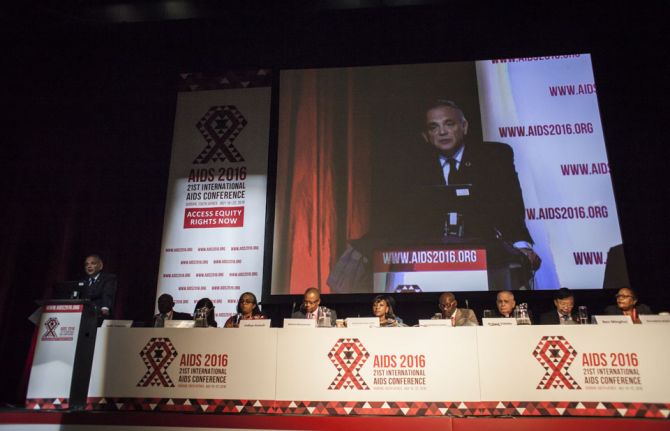
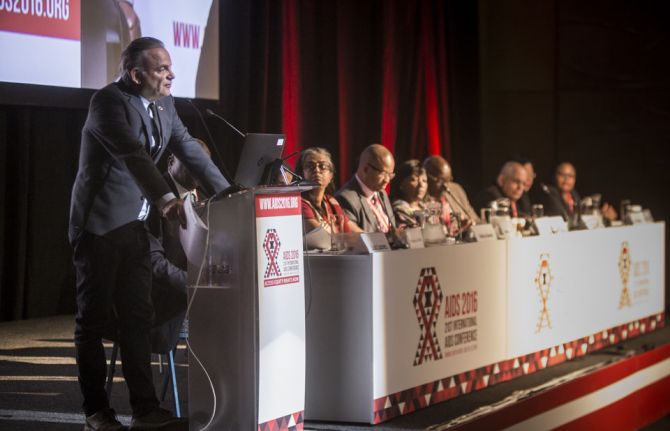
Update
New global push to close paediatric HIV treatment gap launched
20 July 2016
20 July 2016 20 July 2016Leading stakeholders involved in paediatric HIV treatment joined together in a special session on 19 July at the 21st International AIDS Conference, being held in Durban, South Africa, to launch an urgent global push to end paediatric AIDS by 2020. In particular, the session focused on reaching the global target of at least 1.6 million children accessing antiretroviral therapy by 2018.
Sustained gains in preventing new HIV infections among children have laid the groundwork to end paediatric AIDS at least a decade sooner than the global target for the epidemic as a whole. However, to end paediatric AIDS, prevention efforts will need to be matched by an equally robust effort to address the treatment needs of children living with HIV.
While children (aged 0–14 years) accounted for 5% of people living with HIV in 2015, they represented 10% of all AIDS-related deaths. Half of all children who acquire HIV perinatally die by their second birthday unless they receive antiretroviral therapy, with peak mortality occurring at 6–8 weeks of life.
Participants in the session included Raymonde Goudou-Coffie, Minister of Health and Public Hygiene of Côte d’Ivoire, Molotsi Monyamane, Minister of Health of Lesotho, David Parirenyatwa, Minister of Health and Child Welfare of Zimbabwe, and high-level representatives of the United Nations Children’s Fund, the World Health Organization, the Elizabeth Glaser Pediatric AIDS Foundation, ELMA Philanthropies and Caritas Internationalis.
The session resulted in an urgent call to increase political commitment for paediatric HIV treatment, rapid scale-up of point-of-care diagnostic tools for children, intensifying testing efforts for older children, strengthening service delivery and patient monitoring for mothers and their infants and expanding the array of child-appropriate antiretroviral medicines. The renewed global push to close paediatric treatment gaps support the AIDS-free component of the Start Free, Stay Free, AIDS Free framework launched by UNAIDS and partners.
Quotes
“Lesotho’s adoption of a test-and-treat approach in 2016 is the latest in a series of supportive policies adopted to address paediatric HIV as part of the broader HIV response. Lesotho is exploring innovative approaches to prevent more paediatric HIV infections and improve care for children living with HIV.”
“We have to have a plan and we need to implement this plan to meet our targets for ending paediatric AIDS.”
“There is a real coalition of efforts to end AIDS, including paediatric AIDS. Let’s not waste this opportunity. Let’s do this in a coordinated way, and let’s use UNAIDS to help with this coordination.”
“We need a focused global partnership that brings together all players, with the leadership of government at country level, along with the voices of the children, to propel us to the end of AIDS.”
“Only half of children living with HIV receive antiretroviral therapy, but in those same locations almost 80% of pregnant women living with HIV are receiving treatment. We need to engage communities to increase service uptake and promote service delivery models that are family-centred and integrated within maternal, newborn and child health services.”
“We welcome the targets in the Political Declaration on Ending AIDS to Fast-Track the 90–90–90 targets for children.”
Related


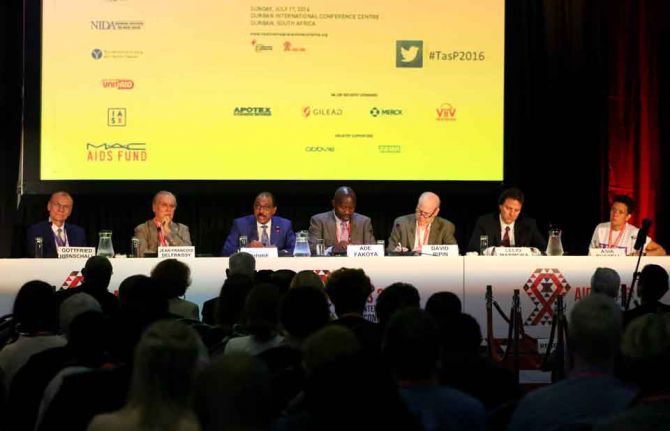
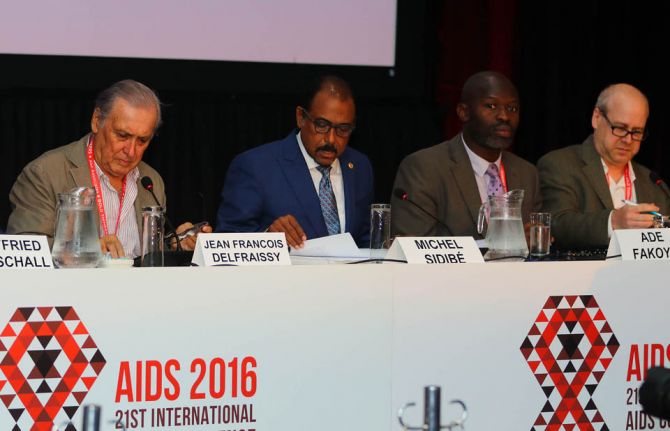
Update
Global gains made towards the 90–90–90 targets
18 July 2016
18 July 2016 18 July 2016Countries are making rapid progress in scaling up HIV testing and treatment across several regions, participants at an event entitled “90–90–90 target workshop: a vehicle for knowledge translation of treatment as prevention” heard.
Taking place at the 21st International AIDS Conference in Durban, South Africa, the event saw the launch of advance draft copies of a new UNAIDS report, 90–90–90: on the right track towards the treatment target. The report highlights best practices and provides examples of countries that are already coming close to achieving the 90–90–90 targets, which are that 90% of people living with HIV know their HIV status, 90% of people who know their HIV-positive status are accessing treatment and 90% of people on treatment have suppressed viral loads.
The meeting heard that in at least 10 countries from diverse regions, HIV treatment coverage either doubled or almost doubled from 2012 to 2015, reinforcing the feasibility of rapid scale-up. Especially encouraging is the rapid expansion of treatment services in certain fragile settings, such as the Democratic Republic of the Congo, where the proportion of people living with HIV receiving HIV treatment also doubled, from 16% to 33% between 2012 and 2015. These encouraging results from diverse countries provide credibility to the attainment of the 90-90-90 targets. However, challenges remain and many countries are struggling to achieve the third 90 target.
The report outlines steps that are needed to expedite gains towards each of the three 90s. Technological and service delivery innovations rapidly need to be brought to scale, communities must be empowered to lead the push to end the epidemic, new resources must be mobilized to reach the final mile of the response to HIV and steps must urgently be taken to eliminate social and structural barriers to service access.
Quotes
“The world is uniting around the Fast-Track response. The 90–90–90 targets have mobilized extraordinary global efforts and are achieving results. We have a fragile window of opportunity to achieve 90–90–90 by 2020 and lay the foundation to end the AIDS epidemic by 2030.”
“Long-term sustainable funding is critical to the success of 90–90–90. Investment of US$ 100 million in the Global Fund to Fight AIDS, Tuberculosis and Malaria saves 60 000 lives, prevents 3.4 million new infections, mobilizes US$ 300 million in domestic resources and saves US$ 2.2 billion in development gains.”
“Declining global investment in malaria led to a resurgence in the disease. The Fast-Track response will become a train wreck if sustainable financing is not secured for the HIV response.”
“The UNAIDS Prevention gap report shows that significant disparities and inequities persist in progress towards the 90–90–90 targets. Inadequate funding is at the core. The US$ 7 billion gap in investments needed for a comprehensive response to HIV is just a rounding error in the budgets of some of the larger donors. We have never had more powerful tools to achieve the end of the AIDS epidemic by 2020. Now is not the time to reduce investment.”
“Many people living with HIV here at AIDS 2016 are alive because of global solidarity behind treatment access at Durban AIDS 2000.”


